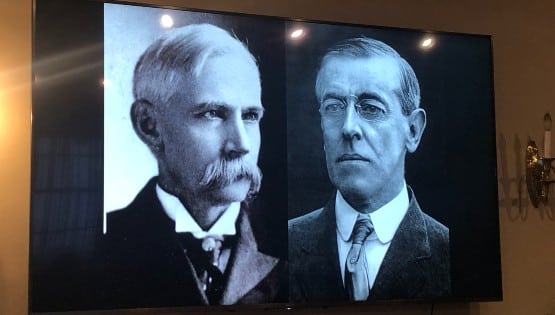Carly at the Movies column by Carl Larsen

Movies came along when Irishmen were still at the bottom of the social ladder, and were stereotypically portrayed as loutish, immigrant toughs with a love for booze, babes, brawling and a New England boiled dinner.
That image began to soften as the years passed (we can thank director John Ford for a lot of that), and by the time we got to the 1930s, Hollywood’s vision of all-things-Irish was glazed over with green glitter, Blarney Stone baloney, and charm thick enough to cut with the same old shillelagh me father brought from Ireland.
In film after film, your typical twinkly-eyed leprechaun was played by either Cecil Kellaway (born in South Africa) or Barry Fitzgerald (from Dublin, at least).
They have a certain allure, even though they are almost uniformly cornball, especially to those movie fans old enough to have been young and impressionable in the ’30s and ’40s. The best of that lot, I’d say, would be “In Old Chicago” (1937) with Tyrone Power in the Chicago Fire/O’Leary’s Cow fable. “The Luck of the Irish” (1048) is fun (if tedious). Tyrone Power’s also in this one, with the redoubtable Ceil Kellaway and Anne Baxter.
Wouldn’t want to forget Bing Crosby (as the crooning Father O’Malley) in “Going My Way,” winner of seven Oscars for its 1944 debut. It’s probably the iconic film for an era when priests looked upon as vessels of pure goodness instead of potential diddlers of altar boys. The sequel to “Going My Way” wasn’t half-bad, either: “The Bells of St. Mary’s” that came along the following year brought in glowing Ingrid Bergman as a nun who could nearly out-saint Bing.
Bing took a trip to Ireland in “Top o’ the Morning” with a returning Barry Fitzgerald. Unfrocked this time, Bing played an insurance adjuster hunting down the stolen Blarney Stone.
Our final entry in the pantheon of truly schmaltzy Irish films is “Little Nellie Kelly” (1940) with, would you believe it, Judy Garland mooning over George Murphy, who was as Irish as a glass of Guinness and who later turned, alas, to politics.
Moving onward (and upward, finally) there are 10 films – all of them set in Ireland itself, as it turns out – that I admire and wouldn’t mind watching again on this day when they dye the river green in Chicago and drink jade-colored beer in New York and other shamrock-obsessed municipalities. Let’s do them chronologically:
“Juno and the Paycock” (1030) and “The Plough and the Stars” (1936) were both based on plays by the great Sean O’Casey; both featured Barry Fitzgerald and both approached the Irish rebellion with brilliant language and a fierce desire for Irish independence. Atwixt the two films, John Ford’s seminal “The Informer” (1935) won four Academy Awards and a spot on the 100 Best Films of All Time list. It was the high point in star Victor McLaglen’s long career.
To many film fans, 1952’s “The Quiet Man” is THE Irish picture. A John Ford labor of love, with McLaglen as Maureen O’Hara’s brawling father and John Wayne in the lead as an American boxer who woos and wins the fair Maureen. Many consider this Ford’s very best film, and it has lots going for it even beyond the splendid supporting cast. (Personally, I like Ford’s cavalry trilogy better. But then, I’m only half-Irish.)
At random times, I still find myself humming the title music from “Hear My Song,” from 1981. Ned Beatty plays the rascally real-life tax evader Josef Locke, famed Irish lover and singer. While the film drifts a bit, the music is something that, like “Laura” and “Breakfast at Tiffany’s,” finds a permanent place in your memory.
OK, let’s take a side trip to weird city, and the world of rebel director John Sayles. In 1994 he released a strange little item called “The Secret of Roan Inish.” Sayles always makes his own kind of movie, and this one starts with your basic 10-year-old girl being sent to live with her grandparents in a small fishing village in Ireland. It gets about as charming as Sayles ever gets, but there’s that underlying sense of uneasiness and the weird legendary stuff starts popping up. I don’t want to spoil it. See it. Beautifully filmed, too.
Talk about your dreary – but totally fascinating – portrait of peasant life in the 1930s in Ireland and “Dancing at Lughnasa” (1998) will always come up. Its five mournfully unmarried sisters, headed by Meryl Streep, who slog through their lives together, rich in nothing but poverty. Not as deep or meaningful as Brian Friel’s Tony award-winning play, but like I said: fascinating.
I just can’t help it, “Waking Ned Devine” (1998) is my favorite film on this distinguished list, even though it plays the quaint-village-full-of-oddball-characters card to the max. If you somehow missed it a decade ago, and are in need of genuine laughter, seek out the DVD.
Now we’re down to the nitty-gritty ugly underbelly stuff. For a real shocker, don’t miss “The Magdalene Sisters” (2002). It’s based on the true story of three girls (among many) raised in a 19th century Magdalene convent/laundry. Tough material, but searingly memorable.
Finally, also from 2002, “Bloody Sunday.” Paul Greengrass’s little masterpiece is filmed like a documentary, bouncing from character to character with no-holds-barred coverage of a 1972 civil-rights protest in Ireland that went tragically wrong.
All the amateur drunks are going to be out driving on St. Pat’s Day, so why not celebrate sensibly, like I’m going to do? Rent a couple of movies from the above list, turn off your cell phone, wolf down a goodly portion of corned beef and cabbage, and spend a pleasant evening in front of the telly, soaking in a tub of Guinness.
Carl Larsen is a regular contributor to The Augusta Free Press. Look for his At the Movies column on Mondays.










